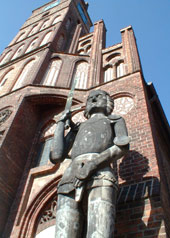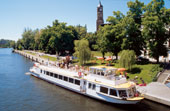Old Town: Altstädtischer Markt (Old Town Market), city hall, Roland, Salzhofufer
After crossing another bridge you enter the Old Town which is partly surrounded by the Havel and the little Beetzsee.
St. Gotthard’s Church (6) was already mentioned in 1147 and is one of the most traditional churches in the march. Across the Altstädtischer Markt (Old Town Market) you pass the Roland (7) and reach the Jahrtausendbrücke (Millennium Bridge).
The old city hall is the representative seat of the mayor, whilst the patron Roland is guarding the official functions. The sandstone Roland, created in 1474, has changed his location several times. He has been standing in front of the city hall since 1946. The oldest Brandenburger wears a knight’s armour and in his bent right arm he holds his sword. With his left hand he clasps a dagger in his belt. This figure is one of the most important medieval statues. Each Whitsun the market place turns into a "Medieval Spectaculum" – the Roland Feast.
On your way to the Millennium Bridge and the Salzhofufer you will pass the Museum in the Frey house (8). It presents a transverse section through town’s history – starting with prehistory and finishing with the end of the GDR. The Salzhofufer that means salt yard shore (9) combines pulsating life on land and on water. The Millennium Bridge connects the Old and the New Town. The shore is a popular anchorage ground for leisure time captains and people drooling for sun. You can lie in nice chairs or you can sit on the terrace of the Fontane Klub and enjoy the beautiful view.
If you feel like getting active, you may rent canoes in all different sizes here. From a boat you can see the city with completely different eyes. Havel, trenches, canals offer many kilometres of inner-city tours: Seagulls squalling and bell-ringing: where are water and land that close? The passenger ship "Pegasus" starts its tours here and "Havelfee" takes off from the opposite shore. On your way along the shore there is another little treasure to explore: the Slavic village. On the other side you can see the "Bauchschmerzenbrücke" (Bellyache Bridge). This bridge has two connections to the wet element. A funny poem by Karl Lauck explains why the bridge is bended: Once the bridge was even, then someone tried to acidise mustard with wine in a nearby mustard mill. Some of that poured into the water and the bridge bended – because of belly ache. You see in (nearly) everything twists around the water.



